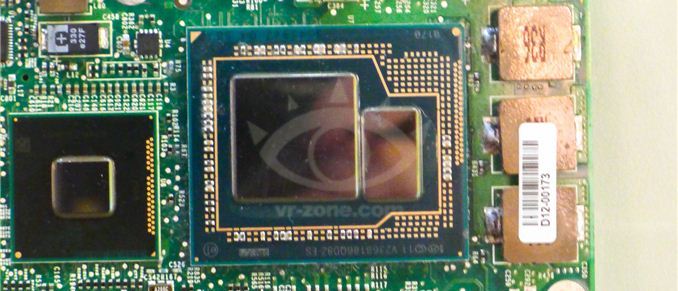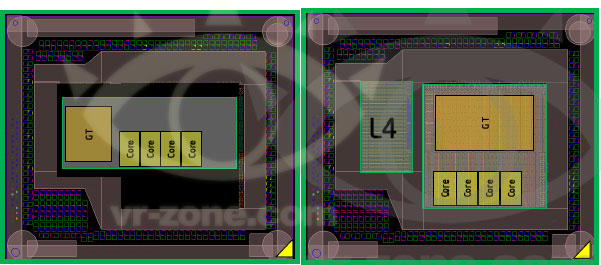Intel's Return to DRAM: Haswell GT3e to Integrate 128MB eDRAM?
by Anand Lal Shimpi on April 23, 2013 11:58 AM EST
We've known for a while now that Intel will integrate some form of DRAM on-package for the absolute highest end GPU configurations of its upcoming Haswell SoC. Memory bandwidth is a very important enabler of GPU (and multi-core CPU) performance, but delivering enough of it typically required very high speed interfaces (read: high power) and/or very wide interfaces (read: large die areas). Neither of the traditional approaches to scaling memory bandwidth are low power or cost effective, which have kept them out of ultra mobile and integrated processor graphics.
The days of simple performance scaling by throwing more transistors at a design are quickly coming to an end. Moore's Law will continue but much like the reality check building low power silicon gave us a while ago, building high performance silicon will need some out of the box thinking going forward.
Dating back to Ivy Bridge (3rd gen Core/2012), Intel had plans to integrate some amount of DRAM onto the package in order to drive the performance of its processor graphics. Embedding DRAM onto the package adds cost and heat, and allegedly Paul Otellini wasn't willing to greenlight the production of a part that only Apple would use so it was canned. With Haswell, DRAM is back on the menu and this time it's actually going to come out. We've referred to the Haswell part with embedded DRAM as Haswell GT3e. The GT3 refers to the GPU configuration (40 EUs), while the lowercase e denotes embedded DRAM. Haswell GT3e will only be available in a BGA package (soldered-on, not socketed), and is only expected to appear alongside higher TDP (read: not Ultrabook) parts. The embedded DRAM will increase the thermal load of the SoC, although it shouldn't be as painful as including a discrete GPU + high speed DRAM. Intel's performance target for Haswell GT3e is NVIDIA's GeForce GT 650M.
What we don't know about GT3e is the type, size and speed of memory that Intel will integrate. Our old friend David Kanter at RealWorldTech presented a good thesis on the answers to those questions. Based on some sound logic and digging through the list of papers to be presented at the 2013 VLSI Technology Symposium in Kyoto, Kanter believes that the title of this soon to be presented Intel paper tells us everything we need to know:
"A 22nm High Performance Embedded DRAM SoC Technology Featuring Tri-Gate Transistors and MIMCAP COB"
According to Kanter's deductions (and somewhat validated by our own sources), Haswell GT3e should come equipped with 128MB of eDRAM connected to the main SoC via a 512-bit bus. Using eDRAM vs. commodity DDR3 makes sense as the former is easier to integrate into Intel's current fabs. There are also power, manufacturability and cost concerns as well that resulted in the creation of Intel's own DRAM design. The interface width is a bit suspect as that would require a fair amount of area at the edges of the Haswell die, but the main takeaway is that we're dealing with a parallel interface. Kanter estimates the bandwidth at roughly 64GB/s, not anywhere near high-end dGPU class but in the realm of what you can expect from a performance mainstream mobile GPU. At 22nm, Intel's eDRAM achieves a density of around 17.5Mbit/mm^2, which works out to be ~60mm^2 for the eDRAM itself. Add in any additional interface logic and Kanter estimates the total die area for the eDRAM component to be around 70 - 80mm^2. Intel is rumored to be charging $50 for the eDRAM adder on top of GT3, which would deliver very good margins for Intel. It's a sneaky play that allows Intel to capture more of the total system BoM (Bill of Materials) that would normally go to a discrete GPU company like NVIDIA, all while increasing utilization of their fabs. NVIDIA will still likely offer better perfoming solutions, not to mention the benefits of much stronger developer relations and a longer history of driver optimization. This is just the beginning however.

Based on leaked documents, the embedded DRAM will act as a 4th level cache and should work to improve both CPU and GPU performance. In server environments, I can see embedded DRAM acting as a real boon to multi-core performance. The obvious fit in the client space is to improve GPU performance in games. At only 128MB I wouldn't expect high-end dGPU levels of performance, but we should see a substantial improvement compared to traditional processor graphics. Long term you can expect Intel to bring eDRAM into other designs. There's an obvious fit with its mobile SoCs, although there we're likely talking about something another 12 - 24 months out.
AMD is expected to integrate a GDDR5 memory controller in its future APUs, similar to what it has done with the PlayStation 4 SoC, as its attempt to solve the memory bandwidth problem for processor based graphics.
Source: RealWorldTech










83 Comments
View All Comments
tipoo - Tuesday, April 23, 2013 - link
It seems very much as if they were made with each other in mind. Even with all the latest updates the Retina Macbook Pros drop too many frames during basic UI animations for my liking, Hasewell with GT3(possibly e) would have been great for it.jasonelmore - Tuesday, April 23, 2013 - link
yeah but who's gonna buy a 15" Retina Macbook Pro with no Dedicated Graphics for $2700? They are still going to have to put DGPU's in it.This will probably go in the 13" but it's gonna run much hotter without a Process shrink.
HisDivineOrder - Wednesday, April 24, 2013 - link
There are many Apple diehards who would buy a Retina Macbook Pro even if it had a Pentium 3 1.13ghz and was on fire at time of delivery.tuxRoller - Wednesday, April 24, 2013 - link
Although I wouldn't buy an apple product until they change some of their policies regarding hardware/software separation, offering this gt3e along with a highend firegl/quadro would be nice. Now, I don't know if infrastructure is there, but imagine having three modes of operation: 1. running the quadro, 2. running the gt3e, 3. running the gt3 with the dram switched off.That's not including the various hybrid modes.
I don't know if this is possible yet, but it would make for some interesting possibilities considering how powerful intel has made their gpus of late.
FITCamaro - Tuesday, April 23, 2013 - link
I'd love to see a Surface Pro with this chip in it.ltcommanderdata - Tuesday, April 23, 2013 - link
As Anand said in the article, GT3e isn't expected to be available in low-power parts suitable for ultrabooks, which is too bad really since that market could benefit from increased IGP performance. Since GT3e is only available in higher power parts where discrete GPU alternatives with the same or better performance are available, its use case seems to be more for BOM/board space simplification rather than directly improving performance constrained situations.lolstebbo - Tuesday, April 23, 2013 - link
Well, Anand also mentioned that the embedded DRAM added heat, so I'd imagine that's a part of why it's not expected to be available in low-power parts suitable for ultrabooks.Death666Angel - Tuesday, April 23, 2013 - link
Yeah, they are making things a bit easier for the OEMs and stealing money from nVidia (and AMD to a lesser part). Good move for them.Kevin G - Tuesday, April 23, 2013 - link
I'd actually be surprised if there isn't a ULV part suitable for ultra books down the line. The catch is that CPU performance would likely have to be further reduced to account for the eDRAM. The other option Intel would have is to make the eDRAM strictly a GPU feature and scale the active amount based upon workloads. In other words, while using a word processing, the eDRAM gated down to 32 MB in size without any L4 cache functionality. While gaming it activates all 128 MB.HisDivineOrder - Wednesday, April 24, 2013 - link
Well, look at the Razer Edge. It includes a discrete GPU. I imagine a few companies will give it a whirl and slap this into something similar that should cost a lot less. In the meanwhile, I imagine AMD/nVidia will be forced to lower their prices to match the GT3e's new baseline for such systems.Could be a decent price drop for better integrated/low-end GPU's.